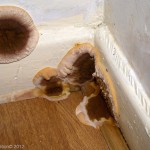Is it Rising Damp or just a plastering problem? Most damp problems can be diagnosed with a good pair of eyes and some experience. However, sometimes problems can be more complex and even the most experienced need more information. One such situation is a rising damp profile or visible rising damp tide mark, where there […]
Chemical Damp proofing reliability (how DryZone changed the rules)
Warning this post is a bit long (but worth it) . What does chemical DPC injection entail? Well, it’s very simple; masonry is porous and most of it readily absorbs water. There is a tendency for any wall to ‘wick-up’ water from the ground it is built into. We’ve all seen the effects.; Rising Damp. […]
BT Preservation & Brick-Tie reach 26 years of service
It’s amazing to think that BT Preservation was incorporated 26 years ago, it seems like yesterday. Dad, brother Stuart and I wanted to take our damp proofing firm (Yorkshire Dampcourse), into wall ties and we chose to start a new subsidiary. Brick-Tie Limited was the result and soon we started using the trading name […]



